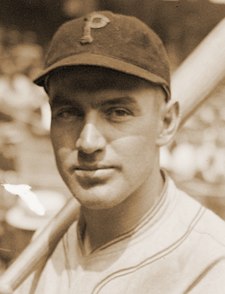| Pie Traynor | |
|---|---|
 Traynor in 1925 | |
| Third baseman | |
| Born: November 11, 1898 Framingham, Massachusetts, U.S. | |
| Died: March 16, 1972 (aged 73) Pittsburgh, Pennsylvania, U.S. | |
Batted: Right Threw: Right | |
| MLB debut | |
| September 15, 1920, for the Pittsburgh Pirates | |
| Last MLB appearance | |
| August 14, 1937, for the Pittsburgh Pirates | |
| MLB statistics | |
| Batting average | .320 |
| Hits | 2,416 |
| Home runs | 58 |
| Runs batted in | 1,273 |
| Stats at Baseball Reference | |
| Managerial record at Baseball Reference | |
| Teams | |
| As player
As manager | |
| Career highlights and awards | |
| |
| Member of the National | |
| Induction | 1948 |
| Vote | 76.9% (eighth ballot) |
Harold Joseph "Pie" Traynor (November 11, 1898 – March 16, 1972) was an American third baseman, manager, scout and radio broadcaster in Major League Baseball (MLB)[1] who played his entire career between 1920 and 1937 for the Pittsburgh Pirates.[1] Traynor batted over .300 ten times, posting a career average of .320, and had seven seasons with over 100 runs batted in (RBI). With home runs limited by playing in Forbes Field, the most difficult park for power hitting in the National League (NL), he compensated by reaching double digits in triples eleven times, leading the league in 1923. He batted .346 in the 1925 World Series to help the Pirates take their first championship in 16 years.
Traynor led NL third basemen in putouts seven times, in double plays four times, and in assists three times; his 41 double plays in 1925 were an NL record until 1950, and his 226 putouts that year remain the highest NL total since 1905. He set major league records for career double plays (303) and games (1,863) at third base which were broken in 1945 and 1960 respectively, and which remained NL records until Eddie Mathews broke them in 1964 and 1965; his 2,289 putouts remain the NL record, and his 3,521 assists were the league record until Mathews passed him in 1964. Traynor was inducted into the Baseball Hall of Fame in 1948, becoming the initial third baseman elected by the Baseball Writers' Association of America.[2]
Following World War II, Traynor was often cited as the greatest third baseman in major league history. In recent years his renown has diminished, with the modern-era careers of third basemen including Mathews, Brooks Robinson, Mike Schmidt and George Brett moving to the forefront in the memories of baseball fans;[3][4][5] however, he is still widely regarded as the top third baseman in the National League prior to 1950.
- ^ a b "Pie Traynor". Baseball Reference. Retrieved October 27, 2010.
- ^ "Pie Traynor at The Baseball Hall of Fame". Baseballhall.org. Retrieved October 27, 2010.
- ^ Kaese, Harold (June 1972). "Pie Traynor Greatest of the Third Basemen". Baseball Digest. Archived from the original on January 13, 2017. Retrieved October 27, 2010.
- ^ James, Bill (2001). The Bill James Historical Baseball Abstract. New York: Free Press. p. 554. ISBN 0-684-80697-5.
- ^ Birtwell, Roger (September 1969). "Pie Traynor Best of All Third Basemen". Baseball Digest. Retrieved October 30, 2010.[dead link]